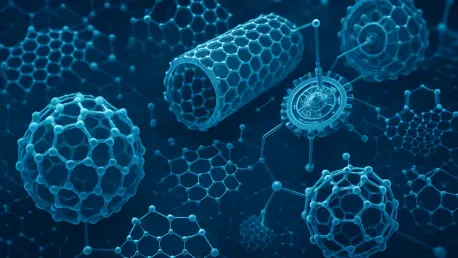In the dynamic domain of nanotechnology, the utilization of nanomaterials is essential for propelling advancements across numerous industries, including electronics, medicine, and environmental science. The caliber of reference materials significantly impacts these developments, as these materials establish critical measurement standards that ensure the accurate and dependable use of nanomaterials. However, the existing reference materials fall short in several aspects, failing to effectively bridge the gap left by incomplete specifications of essential properties like particle shape, size distribution, and composition. Such deficiencies hold substantial ramifications for fields reliant on these materials, particularly in medicine, where nanoparticles play pivotal roles in vaccine formulations and cancer therapeutics. Consequently, addressing these gaps with advanced reference materials is imperative for fortifying the safety and efficiency of nanomaterial applications.
Closing the Gap in Nanomaterial Standards
The Challenge of Incomplete Reference Materials
The urgent need for a substantive foundation in nanotechnology has highlighted significant inadequacies in current reference materials. These existing materials are critical for calibrating scientific instruments, facilitating accurate measurements, and overarching research and development initiatives. Yet, they reveal a notable deficiency in addressing critical aspects, particularly the standardized detailing of particle shape, size, and elemental composition. This shortcoming poses risks across industries, notably in medicine, where nanoparticles are employed in cutting-edge applications like targeted drug delivery. The existing gap inhibits innovation and raises concerns over safety and consistency in applications, underscoring the urgency of developing improved, comprehensive reference materials.
To bridge these gaps, two organizations have made significant strides by developing new reference standards that cater to the increasingly complex requirements of the field. The introduction of innovative references by the Federal Institute for Materials Research and Testing (BAM) and the Metrology Research Centre Canada marks a transformative moment. Their pioneering efforts have led to the creation of iron oxide nanocubes and lipid-based nanoparticles, offering, for the first time, standardized nanomaterials pivotal for advanced medical imaging and drug-delivery systems. This advancement signifies a crucial development in the landscape, as it addresses multiple facets of previously unmet needs in nanotechnology measurement standards.
Introduction of Advanced Nanocubes and Lipid Nanoparticles
The groundbreaking introduction of iron oxide nanocubes provides a new benchmark, representing an industry milestone for precision and standardization in imaging techniques. These nanocubes serve as a pivotal reference for applications requiring high specificity and reliability, such as Magnetic Resonance Imaging (MRI), ensuring that medical diagnostics remain unwaveringly accurate. Equally critical are lipid-based nanoparticles, which have gained prominence due to their quintessential roles in drug delivery, especially in the meticulous delivery of therapeutic agents to target sites in medical applications. This innovation caters to the pharmaceutical industry’s demand for accuracy and safety, supporting the integration of nanotechnology within medical science through enhanced data reliability.
Despite these advancements, addressing other unfulfilled aspects in the spectrum of reference materials remains crucial. Existing standardizations predominantly focus on shape and material composition, yet properties such as surface chemistry and multifaceted characteristics are equally vital. The study underlines that future endeavors must continue to expand upon these elements to keep pace with the evolving intricacies of nano-scale engineering and its array of applications. The development of materials that incorporate these layered features can enhance the capability of industries to adopt highly advanced nanomaterials safely.
Strategic Developments for Future Improvements
Enhancements Through the SMURFnano Project
The European metrology project SMURFnano plays a crucial role by tackling the intricate demands of advancing nanoscale measurement. By focusing on developing robust, validated open-access databases, the project facilitates an improved understanding and usability of characterization data. This endeavor is imperative for researchers and industries as it promotes transparency and accessibility, fueling further research and safe applications of nanomaterials. With the aim of advancing analytic methodologies and reference structures, SMURFnano provides a foundation for ensuring that future reference material standards effectively meet the evolving demands of various technological domains.
The emphasis on expanding databases helps streamline the integration of new references, paving the way for standardized guidelines that increase efficiency in research applications. These resources empower investigators with comprehensive data, fostering innovation through informed decision-making processes. As the landscape continues to evolve, this initiative exemplifies how cooperative international efforts in metrology can facilitate groundbreaking advancements, enhancing safety and efficacy across disciplines involved with nanotechnological materials.
Charting the Path Forward
The pressing need for a solid foundation in nanotechnology has brought significant shortcomings in current reference materials to light. These materials play a crucial role in calibrating scientific instruments and ensuring accurate measurements, thus supporting research and development. However, they fall short in addressing key areas, especially the standardized description of particle shape, size, and elemental composition. This deficiency poses risks across various industries, particularly in medicine, where nanoparticles are crucial for modern applications like targeted drug delivery. The existing gap stifles innovation and raises safety and consistency concerns, emphasizing the urgency for improved, comprehensive reference materials.
In response, two organizations have achieved progress by developing new reference standards for this growing field. The Federal Institute for Materials Research and Testing (BAM) and the Metrology Research Centre Canada have introduced groundbreaking standards. Their work has produced iron oxide nanocubes and lipid-based nanoparticles—standardized for advanced medical imaging and drug delivery. This marks a pivotal development, addressing previously unmet needs in nanotechnology measurement standards.









